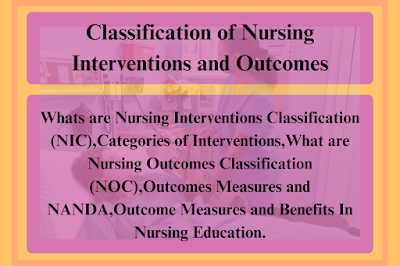Nursing Outcomes Measures and Interventions

Whats are Nursing Interventions Classification (NIC)
Researchers at the University of Iowa developed the Nursing Interventions Classifications (NIC) with a grant from the National Center for Nursing Research. The authors used a national Delphi survey of masters-prepared nurses to generate the original list of 336 specific interventions (Moorehead, McCloskey, & Bulechek, 1993).
Categories of Interventions
Currently, the NIC contains more than 514 research-based, standardized clinical interventions grouped into seven categories:
(1) basic physiological
(2) complex physiological
(3) behavioral
(4) safety
(5) family
(6) health system
(7) community (Dochterman & Bulechek 2004; McCloskey & Bulechek, 2000)
The NIC has been validated by a sample of 121 nurses from the Midwest Nursing Research Society. NIC's creators used input from this survey to revise the original taxonomy. NIC is continuously updated and has an ongoing process for feedback and review (McCloskey & Bulechek, 2000).
NIC is designed to be used by all nursing specialties in any setting. It can also be used by other providers to document their interventions (Dochterman & Bulechek, 2004). NIC is included as one data set that will meet the uniform guidelines for information system vendors in the American Nurses Association's Nursing Information and Data Set Evaluation Center (NIDSEC).
The NIDSEC was established by the American Nurses
Association (ANA) to review, evaluate against defined criteria, and recognize
information systems from developers and manufacturers that support
documentation of nursing care within automated Nursing Information Systems
(NIS) or within Computer-based Patient Record systems (CPR). The
What are Nursing Outcomes Classification (NOC)
In order to complete the requirements for documentation of a nursing clinical encounter, researchers from the NIC team realized the need of a system to classify patient outcomes. Johnson and Maas published the Nursing Outcomes Classification (NOC) in 1997. The 330 outcomes can be used across episodes of care and in various settings.
Outcomes Measures and NANDA
The outcomes have been linked to NANDA International diagnoses, Gordon's functional patterns, the Taxonomy of Nursing Practice, the Omaha Classification System, resident admission protocols used in nursing homes, the OASIS System used in home care, and NIC interventions.
Although the classification system is mostly individually focused (311 of the 330 outcomes are at the individual level), the outcomes can be aggregated to provide some measure of community and family outcomes and an additional 10 family and nine community level outcomes have been developed (Iowa Outcomes Project, Johnson, Maas, & Moorhead, 2000).
Before the development of the classification taxonomies, there was no systematic way to document nursing actions in a common language that novice nurses could use as a guide to the wide array of possible diagnoses, interventions, and outcomes. Although nursing diagnoses have been a part of the organization of most major care planning textbooks since NANDA's inception, there has been no easy way to link nursing diagnosis and intervention with the patient's signs and symptoms, demographic characteristics, medical diagnoses, and therapies.
Outcome Measures and Benefits In Nursing Education
The NIC/NOC system can be used by the nursing instructor to facilitate teaching beginning nurses how to assess a patient and then link that assessment to a list of potential interventions and hoped-for outcomes (McCloskey & Bulechek, 2000). Because the lists are not proscriptive, the student nurse, along with the instructor, must exercise clinical judgment when selecting the intervention.
The classifications cannot replace nursing judgment, nor are they absolutely necessary for nursing decision making to take place, they simply provide one possible systematic way to document and communicate about nursing actions. Each of the databases has different advantages for different users. The NANDA diagnosis classification scheme is probably the most widely recognized method for categorizing nursing diagnoses.
This scheme, however, does not offer a taxonomy for interventions and outcomes. The OCS is a more complete classification system because it does include taxonomies for diagnoses, interventions, and outcomes, but it has not changed substantially since the original work. The NIC/NOC, unlike the systems derived in community health settings, was designed to be universally applicable in any care environment.
The NIC/NOC employed panels of nurse experts to develop its taxonomy. The
NIC/NOC have evolved after several stages of development and validation. Only
NANDA, NIC, and NOC have ongoing research efforts to keep them current
(Dochterman & Bulechek, 2004). The three systems have now been integrated
since the formation of the NIC/NOC/NANDA (NNN) Taxonomy of Nursing Practice.




Give your opinion if have any.